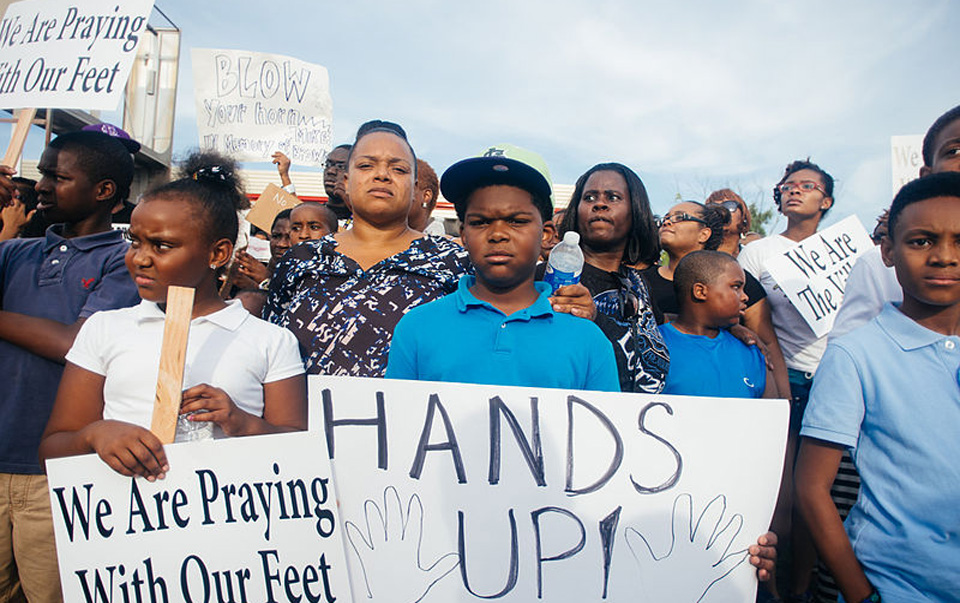
Eighteen-year-old Michael Brown died at the hands of former Ferguson police officer Darren Wilson two and a half years ago. And despite national outrage, a nearly-continuous wave of protests over police extra-judicial killing of young Black people, and federal investigations, new information is surfacing that suggest that what we thought we knew about the fatal August 9, 2014 encounter may be wrong.
Timeline
Sunday (March 12): Documentary filmmaker says new surveillance footage proves Michael Brown did not rob Ferguson Market.
Monday (March 13): Robert McCulloch, St. Louis Country Prosecutor, releases the raw surveillance footage.
Tuesday (March 14): Darren Wilson admits to using the N-word in a court document released to the Washington Post.
Stranger Fruit
As reported earlier in People’s World, Director Jason Pollock’s documentary “Stranger Fruit” showed previously undisclosed footage of Michael Brown inside the Ferguson Market convenience store 11 hours before his alleged “strong-arm robbery” of the store.
Pollock and Brown’s mother, Lesley McSpadden, believe that the footage shows Brown trading marijuana for cigarillos. Pollock learned about the additional surveillance video through his review of the police report
“Mike traded the store a little bag of weed and got two boxes of cigarillos in return,” Pollock says in the documentary. “He left his items at the store and he went back the next day to pick them up. Mike did not rob the store.”
St. Louis County Prosecutor Robert McCulloch said the surveillance video shown in the documentary was known to police and investigators and was deemed “not relevant or admissible” to the grand jury weighing charges against Wilson.
The footage Pollock used was altered. In the 17-minute raw video, released by the McCulloch’s office, Brown is shown apparently bartering with store employees, who refuse the small “bag of weed.” Brown then returns the merchandise, takes back the small bag and leaves the store. Employees then return the items to shelves and cooler.
Regardless of what happened in the store in the early-morning hours, the raw footage and documentary, does not answer any questions about Brown’s later encounter with Wilson.
Racial slurs, Ferguson police, and questionable testimony
On Tuesday, March 14, 2017, the Washington Post reported on court filing in which Wilson responded to questions about the night of Brown’s killing.
The public document, which was filed in the wrongful death lawsuit by Brown’s family against the city of Ferguson, Wilson and former Ferguson police chief Tom Jackson, shows that Wilson had repeated racist remarks: “I have repeated a racist remark made by someone else, but I have not made a racist remark against another individual while on duty as a police officer.”
When asked if he and other officers used the n-word to refer to African-Americans: “Admitted.”
Wilson also confirmed that he had been previously accused of racial discrimination and using excessive force. No information was found about whether those complaints were investigated or sustained.
Ferguson city officials have said Wilson’s disciplinary record was clean.
An article in the Root magazine took Wilson’s answers, of his encounter with Brown, as contradictions to the answers given during the grand jury investigation. Specifically, the author questions the details regarding Brown’s attempts to grab Wilson’s holstered gun and assault.
In the new court filing, Wilson says that Brown didn’t try to take the gun out of his holster; this doesn’t exactly contradict the grand jury testimony in which he said that Brown had hit him so he drew his weapon and Brown tried grabbing it.
The Root article’s author clarified his position, after criticism from a Washington Post reporter, to say that Wilson’s answers in the court document didn’t necessarily contradict his testimony to the grand jury — but that they contradicted “what everyone believed about the incident.”
Indeed, the narrative of Michael Brown being an 18-year old thug and/or criminal, which was presented by Ferguson police following his killing, can no longer be accepted as fact given recent revelations. The video footage of Brown in the convenience store, and Darren Wilson’s admission that he used the n-word in the course of conducting his police duties in Ferguson, raise even more questions about the forces that Brown was up against, and about what may have happened that night.
A community reacts
Residents and activists are now demanding the Ferguson city council close Ferguson Market and Liquor, where Brown was the night before his death and which has come to symbolize the blight and disinvestment in the community.
Instead, residents have proposed replacing it with a local fresh food grocery store or bank – a type of business that would represent renewed investment in the health and well-being of the community.
In the mean time, activists have called for a boycott of the market and have begun to gather petition signatures in an effort to influence the city council’s decision. And with the April 4, 2017 Ferguson mayoral election just around the corner, progressive change is a real possibility.












Comments